Select images
We have assembled a few of the Codex Gigas’ most beautiful pages here. They are just a small part of the big book.
The images give you an idea of the variety and richness of the manuscript's artful decoration. Among other things, you will see the famous portrait of the Devil from which the book takes its nickname.
Pictures
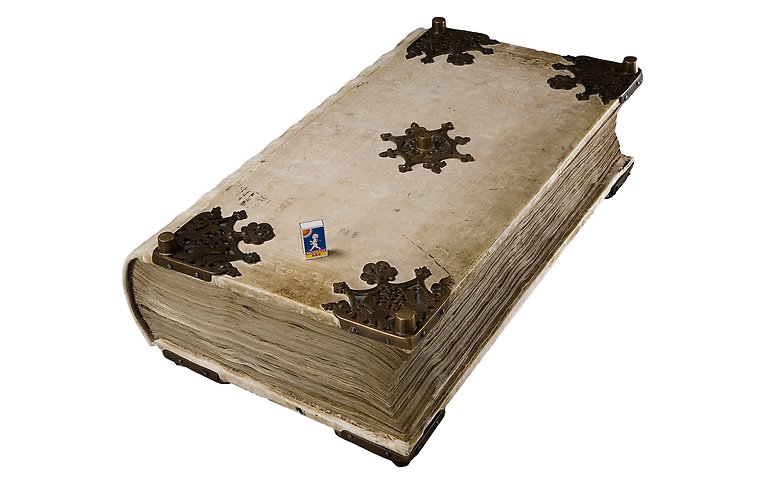
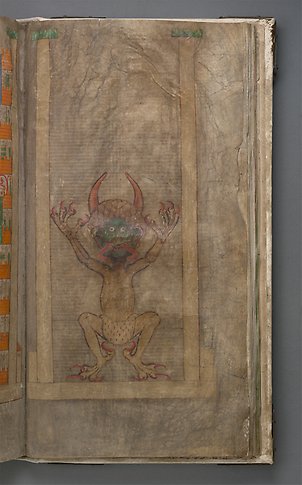
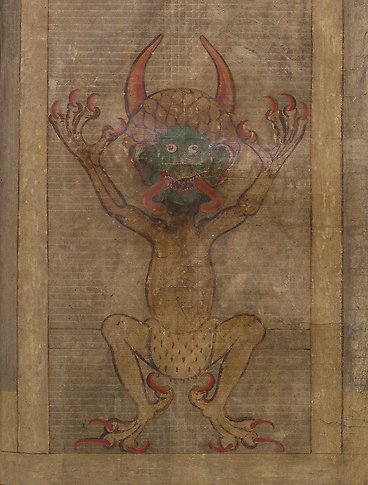
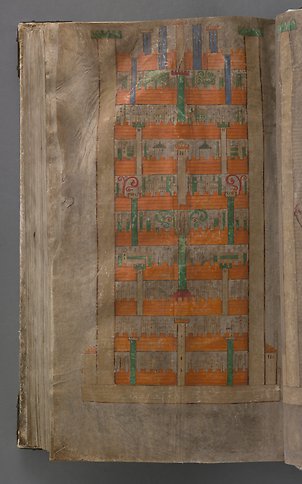
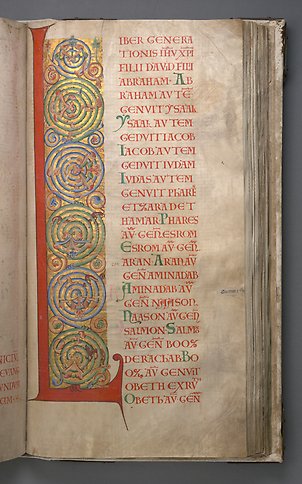

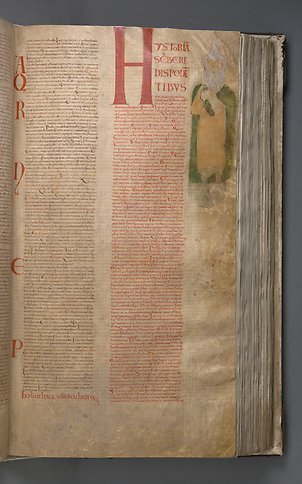
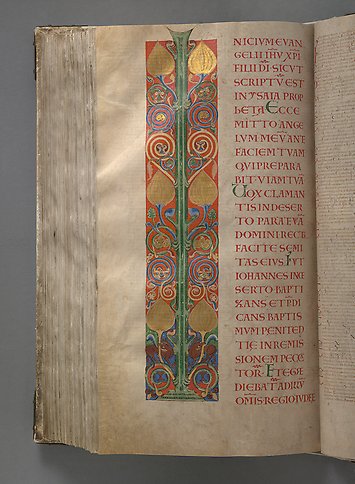

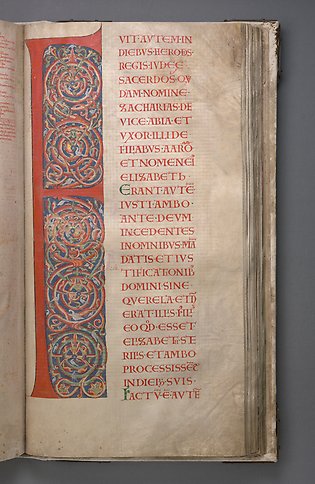

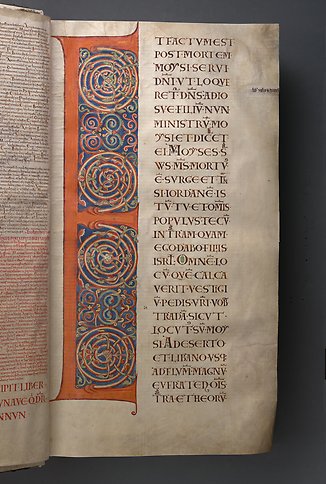
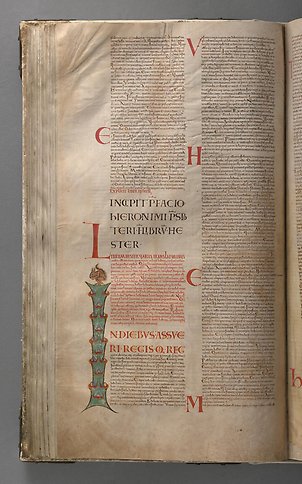
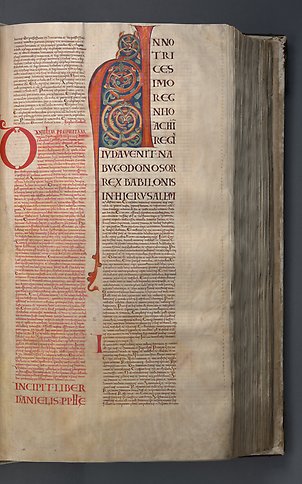
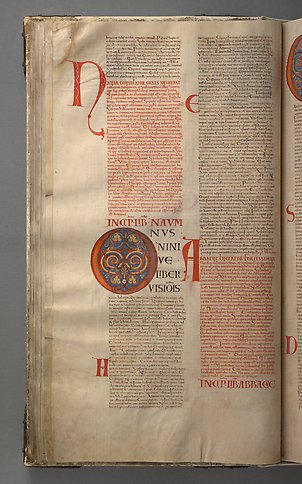
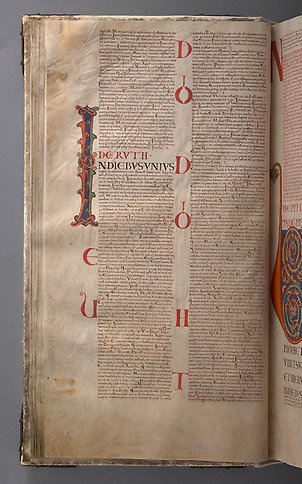
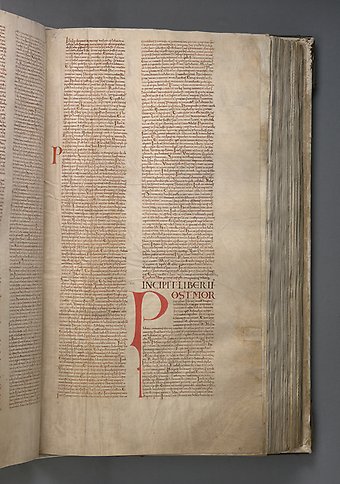

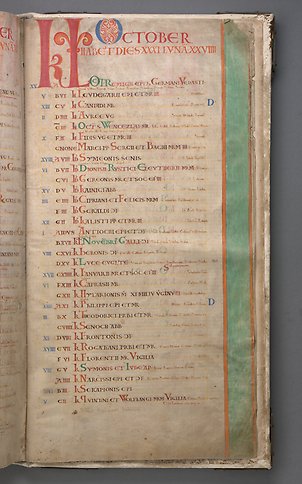
- Description
- The Codex Gigas weighs 75 kg and has 310 parchment leaves. The leaves are 890 mm high and 490 mm wide, which probably makes the Codex Gigas the world's largest preserved medieval manuscript.
- Photo
- Per B. Adolphson / KB
- Copyright
-
You may use the image freely if you provide the name of the photographer.
Read more about CC BY 4.0
- Description
- The portrait of the Devil is the most famous image in the Codex Gigas and is the source of the book's nickname – The Devil's Bible. The Devil is frequently depicted in medieval art, but the portrait in the Codex Gigas is highly unusual in that it is a full-page depiction showing only the Devil.
- Photo
- Per B. Adolphson / KB
- Copyright
- You may use the image freely if you provide the name of the photographer.
- Description
- The Devil is shown alone in a deserted landscape, framed by two high towers. He is squatting with his arms held up (he has only four fingers and four toes) and is wearing an ermine loincloth. Ermine is usually associated with royalty and is likely being used here to emphasise the Devil's position as the Prince of Darkness.
- Photo
- Per B. Adolphson / KB
- Copyright
- You may use the image freely if you provide the name of the photographer.
- Description
- Heavenly Jerusalem, the City of God, is depicted in tiers, each with buildings and many towers (probably church towers) behind red walls. There are more towers projecting from the walls. The city is framed by two high towers, just like the Devil's portrait on the page opposite. The City of God symbolised hope and salvation, serving as a contrast to the Devil's portrait.
- Photo
- Per B. Adolphson / KB
- Copyright
- You may use the image freely if you provide the name of the photographer.
- Description
- The initial L (from Liber) in the Gospel According to St. Matthew occupies an entire column and runs the full height of the page. It is followed by the first thirteen verses of the gospel in red capital letters, apart from the first letter of each verse, which is green. This is the first initial in the manuscript to use gold.
- Photo
- Per B. Adolphson / KB
- Copyright
- You may use the image freely if you provide the name of the photographer.
- Description
- In the margin, near the beginning of Josephus’ Antiquities of the Jews, there are two circular pictures that illustrate the beginning of the Creation story. At the top is the blue sky, with stars and the sun and moon. Earth is shown below as a green orb.
- Photo
- Per B. Adolphson / KB
- Copyright
- You may use the image freely if you provide the name of the photographer.
- Description
- There is a standing figure of a man in the margin on the page on which Josephus' Antiquities of the Jews begins. The bearded figure is not introduced by any text, but this is probably the author of the work – Josephus Flavius – who lived in the first century AD. This is the only portrait of a person found throughout the Codex Gigas.
- Photo
- Per B. Adolphson / KB
- Copyright
- You may use the image freely if you provide the name of the photographer.
- Description
- The “I” initial is one of six that take up a whole page. This initial marks the beginning of the Gospel According to St. Mark.
- Photo
- Per B. Adolphson / KB
- Copyright
- You may use the image freely if you provide the name of the photographer.
- Description
- This initial marks the beginning of the Book of Kings and is one of six full-page initials.
- Photo
- Per B. Adolphson / KB
- Copyright
- You may use the image freely if you provide the name of the photographer.
- Description
- This initial marks the beginning of the Gospel According to St. Luke and is one of six full-page initials.
- Photo
- Per B. Adolphson / KB
- Copyright
- You may use the image freely if you provide the name of the photographer.
- Description
- This initial marks the beginning of the Gospel According to St. John and is one of six full-page initials.
- Photo
- Per B. Adolphson / KB
- Copyright
- You may use the image freely if you provide the name of the photographer.
- Description
- This initial marks the beginning of the Book of Joshua and is one of six full-page initials.
- Photo
- Per B. Adolphson / KB
- Copyright
- You may use the image freely if you provide the name of the photographer.
- Description
- Initial, which appears at the beginning of the Book of Esther, is shaped like a large tree stump on which a squirrel is perched, eating a nut. The realistically rendered squirrel actually serves as the dot over the I here.
- Photo
- Per B. Adolphson / KB
- Copyright
- You may use the image freely if you provide the name of the photographer.
- Description
- The initial “A” for Anno in the Book of Daniel fills part of a column. It is followed by black uppercase letters that lead into the text. The initial is red, with outlines in dark red, and is adorned with spirals on a blue background. The spirals are red, green and yellow, with stylised leaves and grape clusters.
- Photo
- Per B. Adolphson / KB
- Copyright
- You may use the image freely if you provide the name of the photographer.
- Description
- An example of one of the smaller initials in Twelve Minor Prophets.
- Photo
- Per B. Adolphson / KB
- Copyright
- You may use the image freely if you provide the name of the photographer.
- Description
- A smaller multi-coloured initial that leads a paragraph in the Book of Judges.
- Photo
- Per B. Adolphson / KB
- Copyright
- You may use the image freely if you provide the name of the photographer.
- Description
- The Codex Gigas was written entirely by a single scribe in a script called Carolingian minuscule. This script is easy to read, because the letters are very similar to those we use in books, newspapers and magazines today.
- Photo
- Per B. Adolphson / KB
- Copyright
- You may use the image freely if you provide the name of the photographer.
- Description
- In Isidore’s Etymologiae, 11 of the initials are arabesque, with the letters appearing in blue and the leaf ornamentation in red.
- Photo
- Per B. Adolphson / KB
- Copyright
- You may use the image freely if you provide the name of the photographer.
- Description
- The calendar in the Codex Gigas contains saints’ feast days for each day, which is unusual. The system used to number the days may seem odd to modern readers, but it is easy to understand in this context, as the first row corresponds to the first day of the month and the last row to the last day.
- Photo
- Per B. Adolphson / KB
- Copyright
- You may use the image freely if you provide the name of the photographer.
